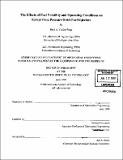The effects of fuel volatility and operating conditions on sprays from pressure-swirl fuel injectors
Author(s)
VanDerWege, Brad A. (Brad Alan)
DownloadFull printable version (16.22Mb)
Advisor
Simone Hochgreb.
Terms of use
Metadata
Show full item recordAbstract
Optimal design of modern direct injection gasoline engines depends heavily on the fuel spray. Most of the studies published regarding these fuel sprays involve cold bench tests or motored optical engines, neglecting the roles of the fuel volatility and temperature. This study, therefore, was designed to describe changes in the spray properties due to fuel volatility and operating conditions using a firing optically-accessible engine. Planar laser-induced fluorescence and planar Mie scattering imaging experiments were performed to show changes in the spray structure, including its radial and axial penetration. Phase-Doppler particle analysis experiments were included to track the droplet diameter and velocity at various points throughout the spray. A computational fluid dynamics model was also used to study the physics leading to the observed changes. The results show that the spray structure changes with not only ambient gas density, which is often measured, but also fuel temperature and volatility. The mean droplet diameter was found to decrease substantially with increasing fuel temperature and decreasing ambient density. Under conditions of low potential for vaporization, the observed trends agree with published correlations for pressure-swirl atomizers. As ambient density decreases and fuel temperature increases, the volatile ends of multi-component fuels evaporate quickly, producing a vapor core along the axis of the spray. Beyond a certain point, evaporation is violent enough to cause additional breakup of the droplets. A fit to this volatility-induced breakup data provides an additional correlation for determining the mean diameter of volatile sprays. Coincident with the volatility-induced breakup trend is an increase in the initial cone angle of the spray. However, the reduced droplet diameter and rapid vapor generation under these superheated conditions result in a narrow spray with increased axial penetration. In the process of performing these experiments, insights were found regarding the operation of these diagnostics in high-density sprays.
Description
Thesis (Ph.D.)--Massachusetts Institute of Technology, Dept. of Mechanical Engineering, 1999. "June 1999." Includes bibliographical references (p. 205-208).
Date issued
1999Department
Massachusetts Institute of Technology. Department of Mechanical EngineeringPublisher
Massachusetts Institute of Technology
Keywords
Mechanical Engineering